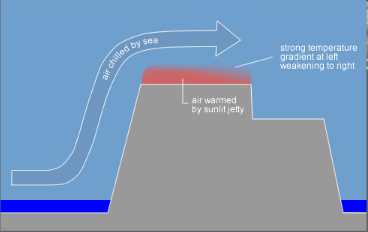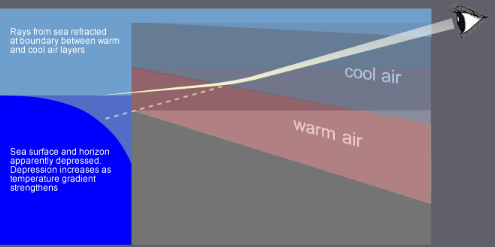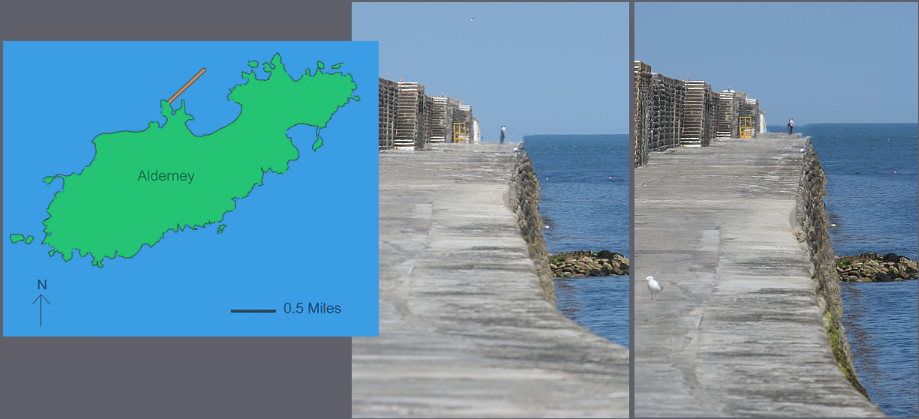OPOD - Waterfall Sea
OPOD - Waterfall Sea: Exploring the Phenomenon in Detail
Have you ever come across the mesmerizing sight of a "Waterfall Sea"? This peculiar optical effect, resembling a giant waterfall pouring into an abyss, can be observed at the Alderney Breakwater in the Channel Islands. Sandy Robertson, a keen observer of atmospheric optics, has witnessed this phenomenon on multiple occasions. Let's delve into the intriguing science behind this captivating spectacle.
The Alderney Breakwater, an immense structure spanning 3000 feet in length (formerly 4900 feet), was constructed in 1848 as a response to the French breakwater built near Cherbourg. Its purpose was to provide better harbor protection for the Royal Navy's channel fleet. The Breakwater's colossal stone superstructure stands at an impressive height of 33 feet.
The photograph capturing the "Waterfall Sea" was taken on a warm July morning by Sandy Robertson. The gentle breeze blowing from left to right in the image creates an interesting airflow pattern. The sea, cooler than the surrounding air, displays a striking curvature and an asymmetrical mirage effect. This mirage is not a random occurrence but can be explained through scientific principles.
The mirage and visual distortions observed in the "Waterfall Sea" arise from refraction, which occurs due to temperature and density gradients between different air masses. In this case, the layers of air above the sea interact with each other and with the jetty, creating varying temperature gradients along the jetty's length.
When rays from the sea pass through the air layers near the left-hand edge of the jetty, where the temperature gradient is most extreme, they undergo refraction towards the cooler and denser air. As a result, the horizon and the nearer sea surface appear to be depressed downwards, creating the illusion of a waterfall-like effect. The viewing angle along the jetty influences the strength of this effect, with a more oblique angle intensifying the perceived "waterfall."
On the right-hand side of the jetty, the two air slabs mix, leading to weaker refraction and a less severe depression of the horizon. However, the turbulent wake from the jetty causes a wavy distortion in the horizon. The camera position also contributes to the asymmetry observed, with the waterfall effect being most pronounced when the camera looks obliquely along the left-hand side.
The height of the jetty further enhances the mirage. The miraged waves appear mostly beyond the jetty, amplifying the illusion. Interestingly, nearby objects such as fishermen are not significantly affected by the mirage, as they are within or close to the refracting regions.
The presence of a warm air layer above the sea, caused by several hours of bright sunlight on the jetty's top, adds another element to the overall effect. This layer of warm air interacts with the cooler breeze coming off the sea, thickening the warm air layer and enhancing the mirage. Additionally, the cold air above the sea creates an illusion of a raised distant horizon and waves.
It is worth noting that mirages can vary depending on the camera height. Images taken from different heights above the deck level reveal different aspects of the mirage. For example, when the camera is at a lower height, the warm air layer is less disturbed by the left-to-right cooler breeze.
In conclusion, the "Waterfall Sea" phenomenon observed at the Alderney Breakwater is a captivating display of atmospheric optics. Through refraction and temperature gradients, this optical effect creates an illusion of a waterfall pouring into an abyss. The interplay between air layers, jetty structure, camera position, and atmospheric conditions all contribute to this mesmerizing spectacle. So, if you ever find yourself near the Alderney Breakwater on a warm day with a gentle breeze, keep an eye out for this enchanting "Waterfall Sea" phenomenon.

Waterfall Sea
To the left of the jetty the sea pours downwards into an abyss, as though over a giant waterfall. To the right it is also strangely sloping and depressed.
Sandy Robertson has seen this peculiar effect several times at the Alderney (Channel Islands) Breakwater. The structure is immense. It is currently 3000ft long (once it was 4900 ft) with a stone superstructure some 33 feet high. Construction started in 1848 in response to the building of a French breakwater at nearby Cherbourg and the perception that the Royal Navy needed better harbours to protect its channel fleet.
©Sandy Robertson, shown with permission


The image, one of several, was taken late morning on a warm July day. A gentle breeze came off the sea – from left to right in the photograph. The sea was cooler than the air but there are no measurements near the breakwater itself. The left, seaward, wall remained in shadow until afternoon. The breakwater is a solid barrier to the air flow with no recirculation possible.
The apparently precipitously curved sea surface and the left – right asymmetry of the mirage is most unusual. That it has been seen more than once reassures that an explanation can be found without having to evoke freak and untestable circumstances.
The jetty top had seen several hours of bright sunlight and would in still air produce a layer of warmed air immediately above it. The gentle left to right breeze carries air cooled by contact with the colder sea up the left seaward side of the jetty and over the warm air layer, thickening the latter in the process.
At the left side of the jetty the layers have a relatively sharp boundary with a steep temperature gradient at the interface. In passing over the jetty the layers interact and the vertical temperature gradient decreases from left to right.
Mirages and visual distortions arise from refraction in the temperature (and thus density) gradients between bodies of air at different temperature. The refraction severity and the strength of the mirage depend on steepness of the temperature gradient.
Looking along the jetty towards its left hand edge, rays from the sea pass between the air layers where the temperature gradient is most extreme. Rays are always refracted in the direction towards the cooler and dense air – upwards in this case. Rays from the horizon appear to come from a point lower down in the sea. The horizon and the nearer sea surface appear to be depressed downwards. The more oblique the viewing angle along the jetty the stronger is the effect which produces the ‘waterfall’.
On the right hand side of the jetty, mixing of the two air slabs has occurred and refraction is weaker. We see an horizon less severely depressed but wavy in the turbulent wake from the jetty.
The left-right asymmetry depends also on the camera position and the waterfall is most apparent when it looks obliquely along the left - hand side. The cold air above the sea further enhances the overall effect by appearing to raise the distant horizon and waves.
The height of the jetty plays a role too in that the miraged waves are mostly at some distance beyond it. This enhances the mirage. Relatively nearby objects like the fishermen (see below) are within or close to the refracting regions and are not affected.
My thanks to Andrew Young for the above interpretation. Errors and ambiguities are mine!

The mirage from 9 feet above the deck level
Alderney in the English Channel off the coast of France and its breakwater

Mirages alter with camera height. Images from 2 and 5 feet above the lower right hand deck. Here the warm air layer is less disturbed by the left to right cooler breeze.
Note: this article has been automatically converted from the old site and may not appear as intended. You can find the original article here.
Reference Atmospheric Optics
If you use any of the definitions, information, or data presented on Atmospheric Optics, please copy the link or reference below to properly credit us as the reference source. Thank you!
-
<a href="https://atoptics.co.uk/blog/opod-waterfall-sea/">OPOD - Waterfall Sea</a>
-
"OPOD - Waterfall Sea". Atmospheric Optics. Accessed on December 18, 2024. https://atoptics.co.uk/blog/opod-waterfall-sea/.
-
"OPOD - Waterfall Sea". Atmospheric Optics, https://atoptics.co.uk/blog/opod-waterfall-sea/. Accessed 18 December, 2024
-
OPOD - Waterfall Sea. Atmospheric Optics. Retrieved from https://atoptics.co.uk/blog/opod-waterfall-sea/.